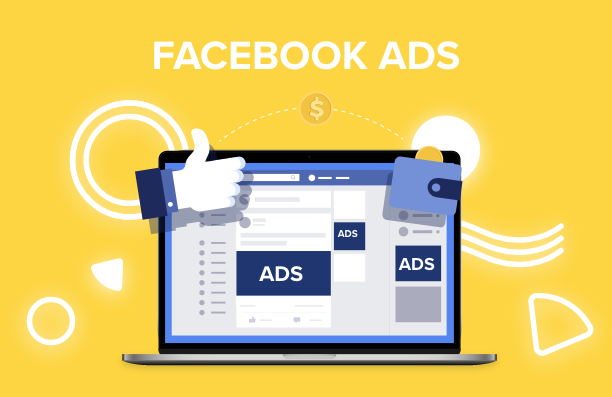Facebook marketing is an effective way for companies to reach a worldwide audience. By utilizing the platform’s varied ad formats and targeting choices, companies may target particular demographics, increase website traffic, and strengthen brand awareness. A successful campaign is built on the foundation of insightful data and engaging content, which promotes customer loyalty and business expansion. Facebook marketing can be a powerful tool for promoting businesses, products, or services. Here’s a step-by-step outline to guide you through the process:
Define Your Goals and Audience
Defining your goals and audience is like having a clear plan. Goals are what you want to achieve, like getting more people to visit your website or buy your product. Your audience is the group of people you want to reach, like young adults who like cooking. Knowing them helps you create content that they’ll like. So, if your goal is to sell cooking tools, you’d focus on showing them to young adults who enjoy cooking. This way, you’re not just putting things out there, but you’re talking to the right people who are interested in what you have to offer.
Set Up a Business Page
Setting up a Business Page is like making a special home for your business on Facebook. It’s where people can learn about what you do. You choose a nice picture for your page, like your logo, and a big picture that shows what your business is about. You also write a bit about your business, like what you sell and how people can reach you. It’s like having a shop sign in a mall so people can find you easily. This page helps you connect with customers and share cool stuff about your business. It’s like your own online store on Facebook.
Create Compelling Content
Creating compelling content means making stuff that people really like and find interesting. It could be pictures, videos, or words that tell a story or show something cool about your business. For example, if you sell clothes, you might share pictures of people looking great in your outfits. It’s like showing off the best parts of your business. Good content makes people want to come back for more and maybe even tell their friends. So, it’s like making your business shine and giving people a reason to be excited about what you do.
Develop a Posting Schedule
A posting schedule is like having a plan for when to share things about your business on Facebook. It’s important because it keeps things consistent. You decide which days and times are best to reach your audience. For example, if people are online more in the evening, that’s when you post. It’s like a TV show having a set time every week. This way, your followers know when to expect new updates from you. Having a schedule helps you stay organized and keeps your audience engaged. It’s like a friendly reminder to keep in touch with your customers regularly.
Engage with Your Audience
Talking and listening to the people who are interested in your business is part of engaging with your audience. It is similar to a cordial conversation. It’s crucial to respond to their messages and comments. This indicates your interest in what they have to say. To involve them, you can also pose fun polls or questions. It’s similar to getting to know new pals on a deeper level. Engaging with your customers fosters a close relationship and mutual sense of trust. They will be more inclined to support your business if you treat them like a wonderful friend.
Utilize Facebook Ads
Using Facebook Ads is like putting up special posters in a busy area to tell more people about your business. These ads can show up on people’s screens, like on their phones or computers. You can choose who sees these ads based on their interests, age, and location. It’s like talking directly to the people who are most likely to be interested in what you offer. You decide how much you want to spend on these ads, and they can help get your business in front of a lot of eyes. It’s a smart way to get noticed!
Budget and Schedule Ads
Budgeting and scheduling ads on Facebook is like planning how much money to spend and when to show your special posters. You decide how much you want to use for your ads, so it’s like setting a limit on your spending. Then, you choose specific days and times for your ads to appear. It’s like deciding when your posters will be up for people to see. This helps you make sure your ads reach the right audience at the best times. It’s like being smart with your money and making sure your message gets out there when it matters most
Stay Updated with Facebook Features
Staying updated with Facebook features means keeping an eye on new things Facebook can do. It’s like knowing about cool tools that can make your business even better. Facebook often adds new buttons, options, and ways to share stuff. For instance, they might introduce a new way to show off your products. By staying updated, you can use these new tricks to make your business page more interesting. It’s like learning about a fun game that has new levels. So, always check for updates – it could help your business stand out and be even more awesome
Comply with Facebook Policies
Following Facebook policies is like playing by the rules on a playground. It means doing things the way Facebook says is fair and safe. They have certain guidelines to make sure everyone has a good experience. For example, they might say not to use bad words or share things that could hurt someone’s feelings. By following these rules, you keep your business page in good standing. It’s like being a good sport in a game – everyone has more fun when everyone plays nicely. So, when you comply with Facebook’s policies, you’re making sure your business is a positive and friendly place to be
Monitor and Adapt to Trends
Keeping an eye on trends and adapting means staying updated with what’s popular and changing in your business world. It’s like knowing the latest cool things that people like. For instance, if a new type of clothing becomes really popular, you might want to offer that in your store. By doing this, you stay in tune with what customers want. It’s like being a good DJ who plays the songs everyone loves to hear. This way, your business stays fresh and exciting, and people are more likely to come back because you’re offering what’s “in” right now!
How to Create Facebook Ads
To create a Facebook ad that drives measurable results, follow these tips.
1. Define your target audience and create ads for them.
While creating ads, it’s tempting to make your messaging vague enough to resonate with everyone. But if you want your Facebook ads to be effective, tailor them to a specific audience.
Before you start creating images/videos and writing ad copy, figure out who is most likely to become paying customers. These are the people you should try to persuade with your ads.
To take things up a notch, use Facebook’s advanced targeting feature to add (or remove) people who follow certain apps, events, or pages. This may take a bit of time, but you’ll increase the ROI of your ad campaigns.
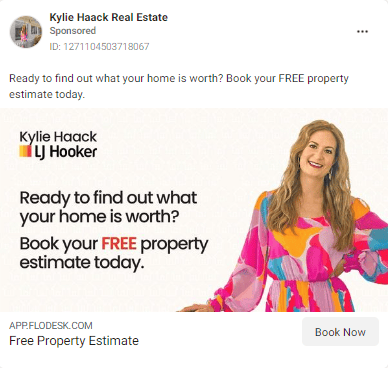
Although Kylie Haack is a real estate company that sells properties, this ad is targeted specifically toward people who want to appraise their homes — not people who want to buy.
2. Write a catchy but clear headline.
Your headline is usually the first thing people will see on your Facebook ad. If it doesn’t catch people’s attention, it will reflect negatively on your click-through rate (CTR) and conversion rate.
With headlines, don’t try to shove your offer down people’s throats. Instead, be clear and conversational, and try to communicate your product’s benefits, if possible.
In this ad, HubSpot is urging people who need help with Facebook or Instagram marketing to check out their free guide on the topic. Their headline for this ad is: Maximize Lead Generation.
This simple, but powerful, headline summarizes the benefits people would get if they read and apply what’s in the free guide.
Pro tip: To improve your headlines and get better results, run split tests (more on that below). These tests can help you determine the messaging that gets people to convert.
3. Don’t use text-heavy graphics.
According to Facebook, images with less than 20% of text perform better. So try not to design graphics with too much text on them.
Text-heavy graphics can distract a prospect from your message, so it’s best to let the graphics speak for themselves. For example, the ad below has too much text.

Image Source
To prevent this from happening, you can use a longer ad caption. But if you must use text on your image, try using a smaller font and fewer words to reduce the proportion of text to image.
4. Use simple and easy-to-understand language.
Ad copywriting is not an avenue to channel your inner Victorian author. It doesn’t matter if you’re an Insta-famous poet or you’ve won a Pulitzer — using verbose language in your Facebook ads will confuse your prospects.
When writing ad copy, the main goal is to make it easy for anyone to understand. When a prospect sees your ad, they should instantly know:
- What your offer is.
- How it will benefit them.
- What to do next.
That’s why I love this Mailchimp ad, which helps people with online stores automate their marketing.
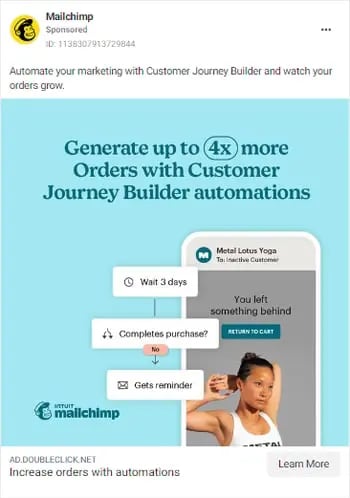
The copy in this ad is simple and to the point: “Automate your marketing with Customer Journey Builder and watch your orders grow.” Then, Mailchimp gives a simplified visualization of what the automation process looks like.
This helps prospects understand exactly how the Customer Journey Builder feature can take things off their plate and help them grow their business.
5. Use social proof in your ads.
When a prospect sees your Facebook ad — especially if it’s the first time — they may not trust your brand or offer immediately. And that’s okay.
It’s your job to convince them that you’re the real deal. A great way to do this is to use social proof in your ads.
Social proof comes in many forms — reactions, comments, shares, testimonials, and reviews. Featuring these in your ads shows prospects that other people have worked with your brand and purchased your offer without any regrets. Once they see this, they may be convinced to be your customer, too.
Before Adobe acquired the company, Figma was really good at using social proof in their Facebook ads.

In the ad above, the product design lead at Onfido, Steve Denis, walks people through how Onfido uses Figma to organize and scale its design systems. The message is simple: If other companies trust Figma to meet their design needs, you can too.
6. Match your Facebook ad to your landing page.
When you run ads on Facebook, you’re essentially telling your audience that if they click your ad, they’ll get exactly what you’re offering on the page your ad leads to.
There’s no quicker way to lose the trust of your audience and increase your bounce rates than to send people to a landing page that has absolutely nothing to do with the offer they were interested in.
When designing your ad and landing page, ensure that the offer promised in the ad is the same as the one on the landing page. You should also include common elements, such as colors, fonts, and images, that will make it easy for people to recognize your offer and convert.
Here’s a great example of ad-landing page sync.

Here, Yoga International is advertising their free breathwork classes that can help people “unwind tension and improve self-healing.” The ad and the landing page it leads to share several design elements.
That includes brand colors, image choices, and fonts. These common elements help prospects feel like the landing page is an extension of the Facebook ad, rather than a new offer entirely.
7. Have a direct call-to-action in your ad.
The perfect Facebook ad should have a clear action the prospect should take.
Some ads are designed to spread awareness about a brand. Other ads lead users to installs, ebook downloads, or sales.
Ideally, ads do both. But to be on the safe side — and to get results that move the needle toward business growth — be clear on exactly what you want your prospects to do after they see the ad.
Calls to action like “Sign up,” “Follow,” “Download,” “Install the App,” and “Shop Now” clearly communicate the desired course of action to a prospect. Without a good CTA, people would see your ad, but they’ll have no idea what to do next.
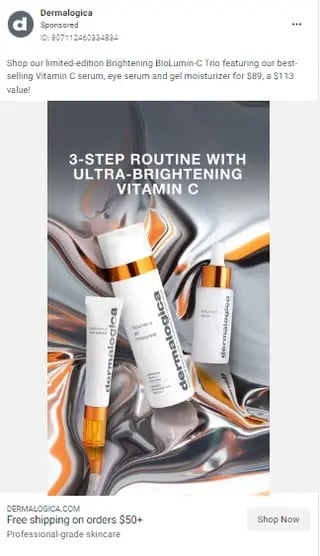
In this ad, Dermalogica, a skincare company, advertises a power trio of three products. Plus, the bundle is less than half of the original prices of the individual products.
The ad is straightforward. It says what the product is, what the discount is, and the perk (free shipping) you get if you buy the product.
The “Shop Now” call-to-action is direct. This indicates that Dermalogica’s goal is for people to click the link and buy the product package.
8. Run A/B tests.
The only way you can improve your Facebook ads is to run split tests on everything — from the headline to ad copy to visuals and CTAs. Sometimes, an ad might not perform well because the copy isn’t convincing enough or the visuals aren’t eye-catching.
To know for sure, create different variations of the same ad — changing one thing at a time — and publish them. Let them run then check to see which version(s) gets the most likes, comments, shares, and conversions.
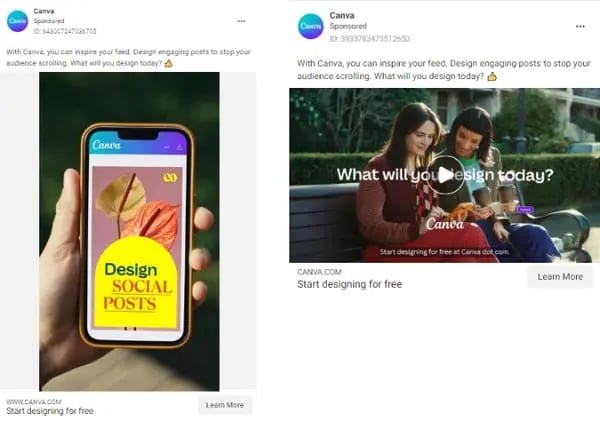
In the instance above, Canva ran A/B tests on the ad creatives. In both ads, the ad copy is exactly the same, but the visual assets are not — one’s an image and the other is a video.
Although the ad copy is the same, the change in visuals can spell a huge difference in the ROI from both ads.

